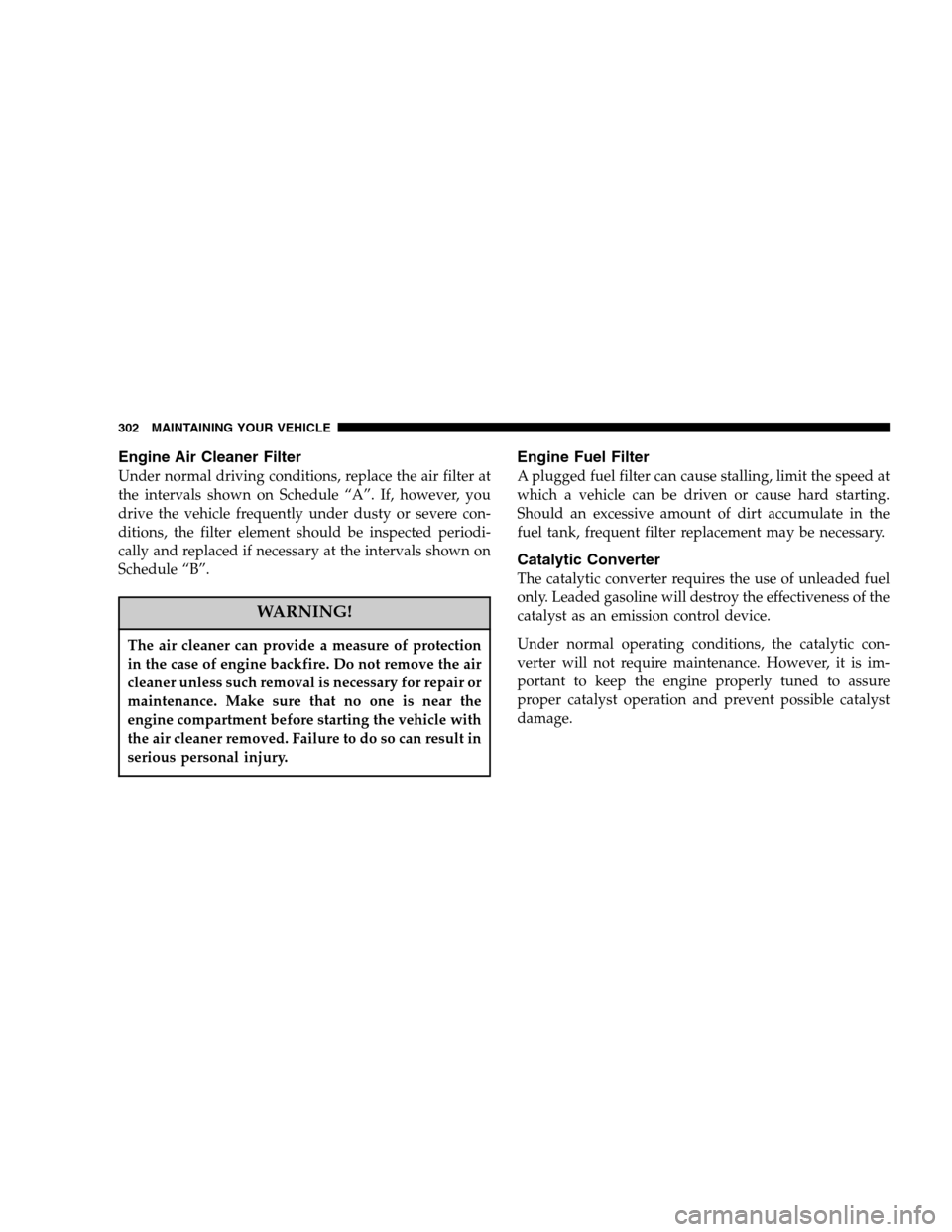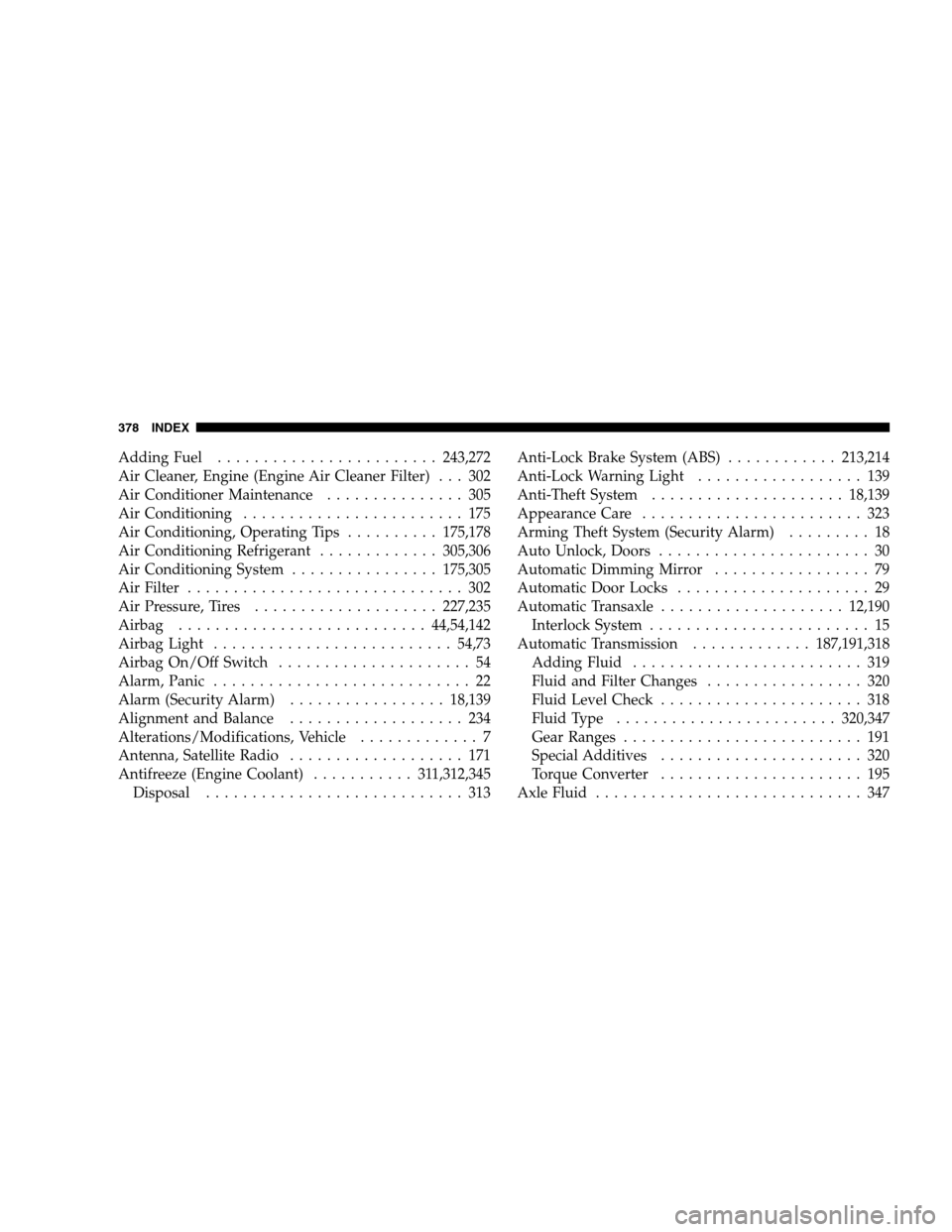Page 263 of 400

If using a manual transmission vehicle for trailer towing,
all starts must be in FIRST gear to avoid excessive clutch
slippage.
Towing Tips — Automatic Transmission
The “D” range can be selected when towing. However, if
frequent shifting occurs while in this range, the “TOW
HAUL” feature should be selected.
NOTE:Using the “TOW HAUL” feature while operat-
ing the vehicle under heavy operating conditions will
improve performance and extend transmission life by
reducing excessive shifting and heat build up. This action
will also provide better engine braking.
The automatic transmission fluid and filter should be
changed if you REGULARLY tow a trailer for more than
45 minutes of continuous operation. See Schedule “B” in
section 8 of this manual for transmission fluid change
intervals.NOTE:Check the automatic transmission fluid level
before towing.
Towing Tips — Tow/Haul (If Equipped)
To reduce potential for automatic transmission overheat-
ing, turn the “TOW HAUL” feature ON when driving in
hilly areas or shift the transmission to Drive position 2 on
more severe grades.
Towing Tips — Electronic Speed Control (If
Equipped)
�
Don’t use in hilly terrain or with heavy loads.
�When using the speed control, if you experience speed
drops greater than 10 mph (16 km/h), disengage until
you can get back to cruising speed.
�Use speed control in flat terrain and with light loads to
maximize fuel efficiency.
STARTING AND OPERATING 263
5
Page 289 of 400
MAINTAINING YOUR VEHICLE
CONTENTS
�3.7L/4.7L Engine Compartment.............292
�Onboard Diagnostic System — OBD II........293
▫Loose Fuel Filler Cap Message............293
�Emissions Inspection And Maintenance
Programs............................294
�Replacement Parts......................295
�Dealer Service.........................296
�Maintenance Procedures..................296
▫Engine Oil..........................297▫Engine Oil Filter......................300
▫Drive Belts — Check Condition And Tension . . 301
▫Spark Plugs.........................301
▫Engine Air Cleaner Filter................302
▫Engine Fuel Filter.....................302
▫Catalytic Converter....................302
▫Maintenance Free Battery................304
▫Air Conditioner Maintenance.............305
▫Power Steering — Fluid Check............306
7
Page 302 of 400

Engine Air Cleaner Filter
Under normal driving conditions, replace the air filter at
the intervals shown on Schedule “A”. If, however, you
drive the vehicle frequently under dusty or severe con-
ditions, the filter element should be inspected periodi-
cally and replaced if necessary at the intervals shown on
Schedule “B”.
WARNING!
The air cleaner can provide a measure of protection
in the case of engine backfire. Do not remove the air
cleaner unless such removal is necessary for repair or
maintenance. Make sure that no one is near the
engine compartment before starting the vehicle with
the air cleaner removed. Failure to do so can result in
serious personal injury.
Engine Fuel Filter
A plugged fuel filter can cause stalling, limit the speed at
which a vehicle can be driven or cause hard starting.
Should an excessive amount of dirt accumulate in the
fuel tank, frequent filter replacement may be necessary.
Catalytic Converter
The catalytic converter requires the use of unleaded fuel
only. Leaded gasoline will destroy the effectiveness of the
catalyst as an emission control device.
Under normal operating conditions, the catalytic con-
verter will not require maintenance. However, it is im-
portant to keep the engine properly tuned to assure
proper catalyst operation and prevent possible catalyst
damage.
302 MAINTAINING YOUR VEHICLE
Page 345 of 400
Fog Lamps
1. Disconnect connector from fog lamp by raising wire
harness lock tab and pulling on wire harness connector.2. Rotate fog lamp bulb 1/4 turn counterclockwise and
pull to remove from fog lamp housing.
3. Reverse Procedure to install.
FLUIDS AND CAPACITIES
U.S. Metric
Fuel
3.7L/4.7L, 87 Octane 22 Gal. 83L
4.7L HO, 91 Octane, Recommended Not Required 22 Gal. 83L
Engine Oil (with filter)
3.7L, SAE 5W-20, API Certified 5 Qt. 4.7L
4.7L, SAE 5W-20, API Certified 6 Qt. 5.7L
4.7L HO, SAE 5W-20, API Certified 6 Qt. 5.7L
Cooling System (includes 2.1 Qts./2L for coolant bottle
3.7L (Mopar�Antifreeze/Coolant 5 Year/100,000 Mile Formula) 13.3 Qt. 12.5L
4.7L (Mopar�Antifreeze/Coolant 5 Year/100,000 Mile Formula) 13.3 Qt. 12.5L
4.7L HO (Mopar�Antifreeze/Coolant 5 Year/100,000 Mile Formula) 13.3 Qt. 12.5L
NOTE:All fluid capacities are approximate capacities.
MAINTAINING YOUR VEHICLE 345
7
Page 346 of 400
FLUIDS, LUBRICANTS AND GENUINE PARTS
Engine
Component Fluids, Lubricants and Genuine Parts
Engine Coolant Mopar�Antifreeze/Coolant 5 Year/100,000 Mile Formula HOAT (Hybrid Or-
ganic Additive Technology) or equivalent.
Engine Oil Use SAE 5W-20, API Certified, meeting material standard MS-6395.
Engine Oil Filter Mopar�Engine Oil Filter, P/N 5281090 or equivalent.
Spark Plugs Refer to the Vehicle Emission Control Information label in the engine com-
partment.
Fuel Selection 3.7L/4.7L 87 Octane, (R+M)/2 Method
Fuel Selection 4.7L HO 91 Octane, (R+M)/2 Method (Recommend, Not Required.)
346 MAINTAINING YOUR VEHICLE
Page 352 of 400

At Each Stop for Fuel
•Check the engine oil level about 5 minutes after a fully
warmed engine is shut off. Checking the oil level while
the vehicle is on level ground will improve the accu-
racy of the oil level reading. Add oil only when the
level is at or below the ADD or MIN mark.
•Check the windshield washer solvent and add, if
required.
Once a Month
•Check tire pressure and look for unusual wear or
damage.
•Inspect the battery and clean and tighten the terminals
as required.
•Check the fluid levels of coolant reservoir, brake
master cylinder, and transmission and add as needed.
•Check all lights and all other electrical items for correct
operation.
At Each Oil Change
•Change the engine oil filter.
•Inspect the exhaust system.
•Inspect the brake hoses.
•Inspect the CV joints (if equipped) and front suspen-
sion components.
•Check the automatic transmission fluid level (if
equipped).
•Check the manual transmission fluid level (if
equipped).
•Check the coolant level, hoses, and clamps.
352 MAINTENANCE SCHEDULES
8
M
A
I
N
T
E
N
A
N
C
E
S
C
H
E
D
U
L
E
S
Page 378 of 400

Adding Fuel........................243,272
Air Cleaner, Engine (Engine Air Cleaner Filter) . . . 302
Air Conditioner Maintenance............... 305
Air Conditioning........................ 175
Air Conditioning, Operating Tips..........175,178
Air Conditioning Refrigerant.............305,306
Air Conditioning System................175,305
AirFilter .............................. 302
Air Pressure, Tires....................227,235
Airbag........................... 44,54,142
Airbag Light.......................... 54,73
Airbag On/Off Switch..................... 54
Alarm, Panic............................ 22
Alarm (Security Alarm)................. 18,139
Alignment and Balance................... 234
Alterations/Modifications, Vehicle............. 7
Antenna, Satellite Radio................... 171
Antifreeze (Engine Coolant)........... 311,312,345
Disposal............................ 313Anti-Lock Brake System (ABS)............213,214
Anti-Lock Warning Light.................. 139
Anti-Theft System..................... 18,139
Appearance Care........................ 323
Arming Theft System (Security Alarm)......... 18
Auto Unlock, Doors....................... 30
AutomaticDimmingMirror ................. 79
Automatic Door Locks..................... 29
Automatic Transaxle.................... 12,190
Interlock System........................ 15
Automatic Transmission.............187,191,318
Adding Fluid......................... 319
Fluid and Filter Changes................. 320
Fluid Level Check...................... 318
FluidType ........................320,347
Gear Ranges.......................... 191
Special Additives...................... 320
Torque Converter...................... 195
AxleFluid ............................. 347
378 INDEX
Page 382 of 400

Emission Related Components.............. 315
Engine
Air Cleaner.......................... 302
Block Heater......................... 189
Break-In Recommendations................ 71
Coolant (Antifreeze).................... 346
Exhaust Gas Caution.................. 72,242
Flooded, Starting...................... 188
Fuel Requirements..................... 345
Jump Starting......................... 283
Oil ...........................297,345,346
Oil Filler Cap......................... 299
Oil Selection.......................... 345
Oil Synthetic......................... 300
Starting............................. 187
Temperature Gauge..................... 136
Entry System, Illuminated.................. 19
Equipment Identification Plate.............. 270
Event Data Recorder...................... 56Exhaust Gas Caution................ 72,242,309
Exhaust System....................... 72,309
Extender, Seat Belt........................ 43
ExteriorLighting ......................... 92
Fabric Care............................ 325
Filters
Air Cleaner.......................... 302
Engine Fuel.......................... 302
Engine Oil........................300,346
Engine Oil Disposal.................... 300
Flashers
Hazard Warning....................... 272
Turn Signal...................... 94,136,338
Flat Tire Stowage........................ 282
Flexible Fuel Vehicles
Cruising Range........................ 247
Engine Oil........................... 246
Fuel Requirements..................... 245
382 INDEX